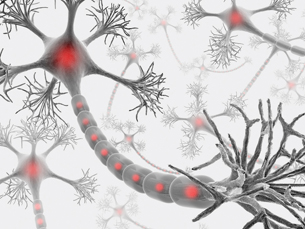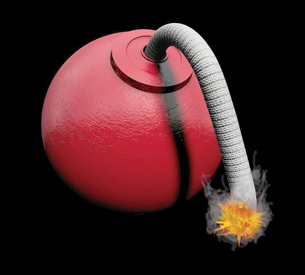Module 1
1. Module 1
1.47. Page 3
Module 1—The Nervous System
 Watch and Listen
Watch and Listen
Communication through the neuron involves a series of action potentials. To master the concepts of neuron communication, watch the following segments of “Nerve Impulse Conduction: Dentists Calms Your Nerves.” Your teacher can help you understand any of these concepts if you feel that you need further clarification after watching the segments.
- “Recording Impulse Conduction”
- “Bio Discovery: The Action Potential”
- “Bio Review: Depolarization”
The Action Potential

© iDesign/shutterstock

© Friax74/Fotolia
When a neuron becomes sufficiently stimulated by a threshold stimulus, the point of stimulation becomes depolarized and the depolarization spreads along the length of the unmyelinated neuron. This depolarization is created by a rapid change in membrane permeability and a corresponding change in the balance of ions maintained at the resting state. Depolarization can be likened to a burning fuse. The flame, like the wave of depolarization, progresses along the wick in one direction. However, in the fuse, the wick is burned and cannot be used again. In the neuron, after the wave of depolarization, an immediate recovery period called repolarization occurs.
action potential: the change in charge that occurs when the gates of the potassium ion channels close and the gates of the sodium ion channels open; a large depolarization event that is conducted along the membrane of a nerve cell or a muscle cell
threshold stimulus: weakest possible stimulus that is needed to initiate a nerve impulse
depolarization: the loss or reduction of the negative resting membrane potential
repolarization: restoring the resting membrane potential (– 70 mV) from the depolarized state
 Read
Read
To understand the next steps in communication, read “Action Potential” on pages 374 to 377 in your textbook. Making summary notes to be stored in your course folder will prove to be invaluable in mastering these concepts. You may wish to create your own illustration of these events and add it to your course folder for review.
 Watch and Listen
Watch and Listen
You may wish to review the “Bio Discovery: The Action Potential” segment in the video “Nerve Impulse Conduction: Dentists Calms Your Nerves.”
For more review of the action potential, go to the McGraw-Hill Ryerson online learning centre at www.albertabiology.ca. Navigate to the Student Resources, and choose “Chapter 11” from the menu on the left side of the screen. From there, choose “Animations.” Select the animations called “Action Potential Propagation in an Unmyelinated Axon” and “Voltage Gated Channels and the Action Potential.” After watching the animations, answer the questions listed below.
Questions for “Action Potential Propagation in an Unmyelinated Axon”
- What is the net charge on the outside of a resting neuron?
- What is the net charge on the inside of a resting neuron?
- Describe the action potential.
- What keeps the action potential going along the axon of the neuron?
- What are localized electrical circuits?
- Why does the action potential proceed only in one direction?
- What is an absolute refractory period?
Questions for “Voltage Gated Channels and the Action Potential”
- Draw an illustration of the voltage-gated Na+ channel and the inactivation gate.
- Draw an illustration of the voltage-gated K+ gate.
- Describe how depolarization occurs and what happens in repolarization.
The Refractory Period and the All-or-None Principle
refractory period: the short time immediately after an action potential in which the neuron cannot respond to another stimulus; period of time it takes to re-establish the net positive charge on the outside of the neuron and the net negative charge on the inside of the neuron, where there are more sodium ions on the outside and more potassium ions on the inside of the neuron
threshold potential: the smallest change in the membrane potential of a cell membrane that is needed to initiate an action potential; approximately – 55 mV
all-or-none response: action that occurs either completely or not at all, such as the generation of an action potential by a neuron
Throughout this module, you have discovered that normal communication involves periods of interruption. In this case, while repolarization was occurring, there was no chance for communication. Another sodium inrush could not occur. This brief period when no stimulus can elicit a response is called the refractory period. Its duration is usually only 1 to 2 ms (milliseconds).
The stimulus that begins the influx of sodium ions and starts depolarization has to be of certain intensity in order to open the voltage-gated sodium channels. Once this voltage shift is reached, a wave of depolarization begins. It doesn’t matter if the voltage shift is higher, because once the gates are open, a wave of depolarization occurs. It is just like lighting the wick in the fuse analogy—either it ignites and begins to burn, or it does not ignite and the wick does not burn. A wave of depolarization is much the same. If the stimulus is not strong enough to open the gates in the neuron membrane, nothing happens. There isn’t a wave of depolarization—so there isn’t a nerve impulse. The voltage shift needed to open the sodium gates is called the threshold potential. This ability of the neuron to only respond to a disturbance in electrical charge of a specific threshold value is called the all-or-none response. Like the wick that either did or did not burn, the neuron either transmits the wave of depolarization or it doesn’t. In an all-or-none response, there are no in-betweens. To help illustrate this concept, consider another analogy—dominos that have been stood up in a line. Once you apply sufficient pressure to the first domino, all of the dominos will fall—there’s no stopping them. Once the threshold potential is reached, there is an all-or-none response that cannot be stopped, resulting in a wave of depolarization and impulse.
 Watch and Listen
Watch and Listen
To view these events, watch the following segments of “Nerve Impulse Conduction: Dentists Calms Your Nerves.”
- “All-or-None Principle”
- “Nerve Impulse”